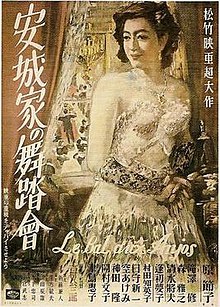Many
times throughout my experiences watching melodramatic pieces I sit there and
question how elements of a story actually contribute to them being “melodrama”
and not just drama. The character’s interactions with one another are generally
big indicators, however exaggerated figurative effects such as character
motivations, perspectives, and dialogue are also often prevalent in films that
rely more on the story being told than the characters interacting. So a large
part of determining a film’s worth in the melodramatic sense is often dependent
on deciphering what form of movie it is, a character-centric one or a
story-centric one. In both cases, an
effect such as a well-timed musical piece reflecting a character’s perspective can
often heighten a dramatic moment to one that is “excessive” enough to be
considered melodrama, such as the ending parade scene in Story of the Last Chrysanthemum. But, these figurative effects, at
their core, are just ancillary devices, and the elevation of drama to melodrama
in story-centric films are actually heavily dependent on the quality of the
story.
To this
degree is where a movie such as China
Nights really fails to deliver in the melodramatic mode. The story,
essentially, is a romantic development between a leading male character – who is
Japanese – and a likewise leading female character – who is Chinese – during a
period of warring between Japan and China. For all intents and purposes, the
story is a propaganda film, devised to portray a kinder, gentler version of the
Japanese to the Chinese locals in Japanese controlled-domains. The development
of the romance between the two characters is, to put it nicely, curiously
convenient. The female Chinese lead, named Kei Ran in the film, is at first
introduced to be alien to this Japanese controlled domain, and her feelings for
the Japanese are squarely unfriendly.

Through the progression of the
film, her tone and behavior towards the Japanese change in-sync with the
treatment and relationship development she has with the male Japanese lead,
named Hase Tetsuo. To that end, any drama that develops within the movie is a
result of international cultural barriers and how people of different
nationalities sometimes just do not know enough about each other (or at least, that
is what the intention of the propaganda was supposed to be). The depiction of
the Japanese in the film was somewhat holier-than-thou, with many moments
dedicated to showing how tender Mr. Hase was and how forgiving the Japanese
people were of war time tragedy, while notoriously the only Chinese character
in the form of Kei Ran was depicted as a rude unrelenting grudge-bearer.
The appeasement of the Japanese
conscience with this film, as it was made during the warring period with China
in the early-to-mid 1900s, is explicitly why is fails so disastrously in
tugging any melodramatic heartstrings with its audience. Naturally, the outline
of the film would seem to be a character-centric one, yet the characters in the
film are so fundamentally blank and crude, that they come across as almost
robotic. Their actions, particularly Kei Ran’s, are tremendously plot convenient.
One fine example of that is Kei Ran’s return to the hotel, after having
essentially “ran away” and worried the entirety of the main cast, especially
Hase. She returns still seething with contempt for the people around her for
being the perpetrators of her homeland’s destruction. In the scene prior, one of the ensemble named
Nobuko, goes on a truly cringe-worthy speech about how both sides in war are bad
and that those burned by the consequences of it should not hold grudges, just
as she, the noble Japanese icon, had not. So, Kei Ran, after having been
baptized on the moralities of war, returns to a flustered group of Japanese
that, for reasons really inexplicable to the audience, care ever so deeply for
her. They shower her with positives reactions, offering her food and shelter
and words of comfort.
Naturally, Kei Ran brashly shoves
it all away and turns to insults as her defense against them. The scene
culminates in a moment where Hase, the gentlemanly kind and caring Japanese
prototype, very violently hits her and knocks her down. He then immediately
retreats from her and breaks down into a pathetic speech about how he was a
victim of hers, how she “beat” him into turning violent (even though he clearly
truly never meant to be violent to her, because for you see, no honest
worthwhile Japanese man would do such a thing). This speech, for truly no
reason, inspires Kei Ran to then see that the Japanese, and specifically Hase,
are actually truly good people that do care for her. In a way, she very clearly
demonstrates some form of Stockholm, or even more morbidly some form of grotesque
battered woman syndrome. Her reaction is
simply indescribably unreasonable.

By generic technical terms, these coupled
scene should be “dramatic”, if not “melodramatic.” But, unfortunately, they are
not. The character interactions are abysmally superficial and illogical. With
the exception of Hase and Kei Ran, the other character’s emotions are virtually
sterile. Nobuko’s speech about grudges is, on its surface, perhaps a correct
one. But the circumstances she describes it in, where she uses her own
experience of suffering from family disasters as a jumping off point for
victim-blaming Kei Ran for not behaving the same as her, are gross. Hase’s
outrage over Kei Ran’s “betrayal”, despite her not really owing him anything as
none of his actions were of her desire or decision, is heavily, heavily forced.
There is no natural charm to the way they interact with each other. All of
their actions simply serve to maintain the story’s over-arching theme about
acceptance of the Japanese people by the Chinese. Kei Ran’s drastic reversal of
her opinion on the Japanese after being physically assaulted makes no real
sense, because physically assaulting someone is not down out of concern for
them, it is down out of concern for control of them.
Simply put, none of their character
interactions make sense. Not from a
logical standpoint, nor from an emotionally driven irrational one. So if the
character interactions are so base, then the primary source for the drama in
the movie is at the mercy of the story and its narrative. And unfortunately, China Nights’ story is too brutally superficial
and underdeveloped to have any real dramatic weight. Therefore, whenever the
characters take action, when seen from the visor of the entire movie, their
behavior changes are always used as a reference point for their actions. And
because these changes are so radical despite not having any real backing, it is
subjectively hard to recognize the dramatic moments of the movie to have any
real merit. And if the dramatic elements are questionable, than the
melodramatic ones are even more so.
There are some reasonable points in
the latter half of the movie, where Kei Ran and Hase have developed honest
romantic feelings, that the drama is somewhat better handled via the narrative.
Specifically, when Hase goes to the frontlines, and his life is put into
question (and the subsequent emotional turmoil this puts on Kei Ran), we see
honest and legitimate reactions to a story by the characters. Kei Ran’s
emotional destruction from believing to have lost a loved one, specifically to war,
is far more believable here. The aftermath of his return, and how they interact
in the final scenes, makes both logical and emotional sense. To that end, one
may be able to describe the latter portion of the movie as drama, and even melodrama
if one considers the potential suicide plot by Kei Ran to have been legitimate.
 |
| Kei Ran potentially attempting suicide before Hase re-appears |
But the problem with China Nights
is that you cannot isolate a portions of the story for praise of its
melodramatic significance, because the story is reliant on the entire “picture”
being seen as one coherent whole. Otherwise, the film would have no actual
purpose, as the point of the propaganda film was international endearment. It
was not a simple movie about a romance between people of different nationalities;
that was only an aspect of it. And if
the motivations, perspectives, and dialogue in this “whole picture” are too disorganized,
presumptuous and forced, then these portions in isolation are contextually
disingenuous. And that is why they cannot be considered real moments of “melodrama,”
as the drama within them is fake to begin with.

























